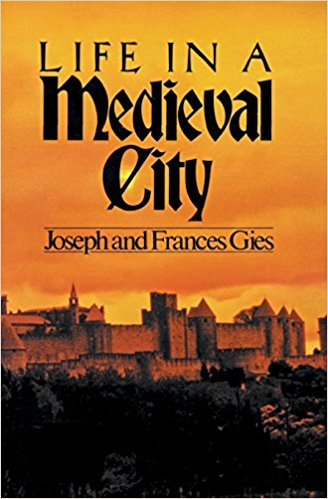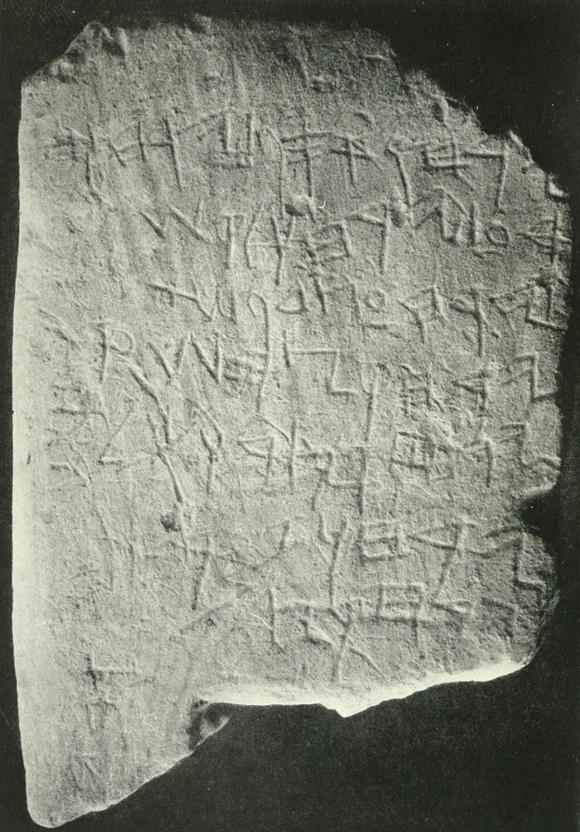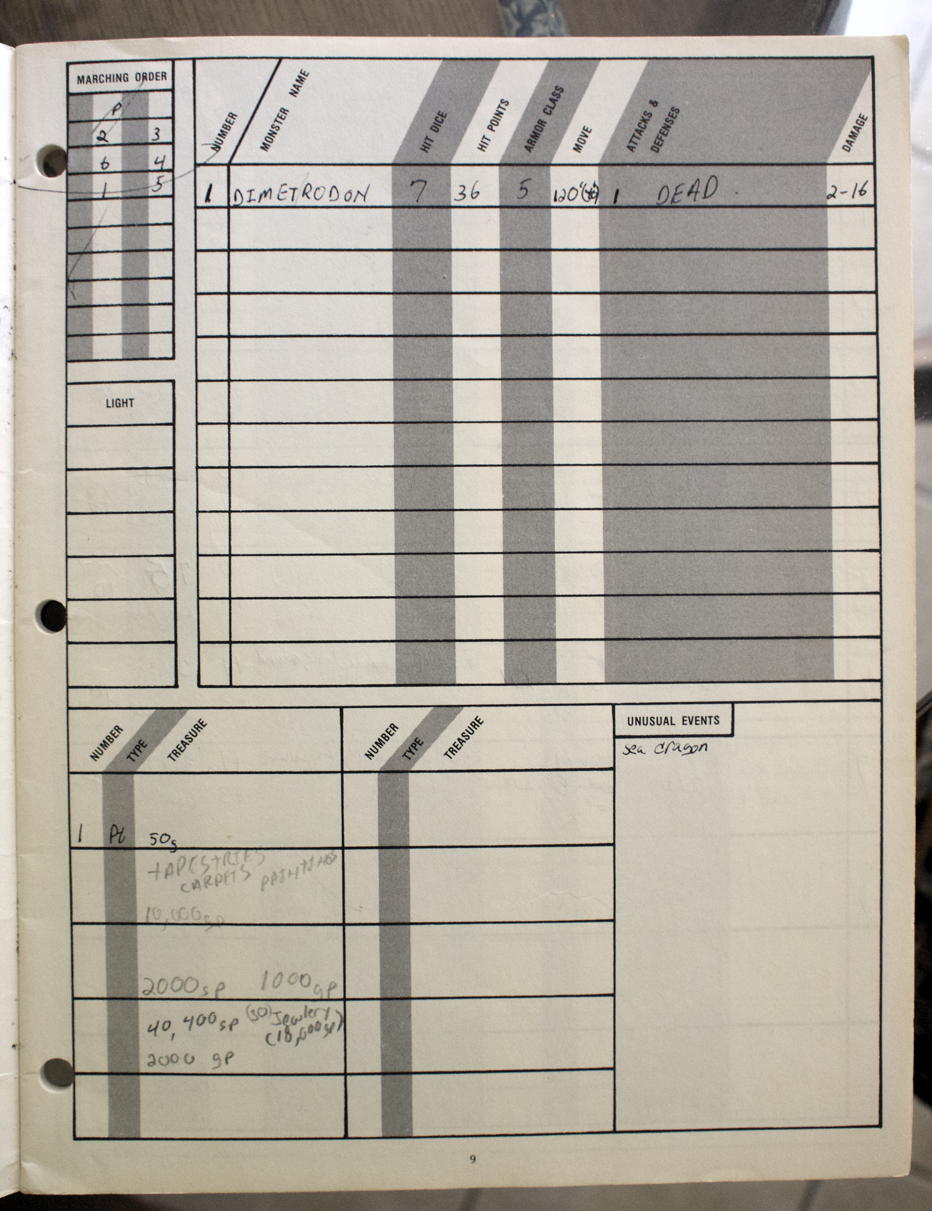-
 Mighty Protectors release: Villains & Vigilantes 3.0—Friday, October 13th, 2017
Mighty Protectors release: Villains & Vigilantes 3.0—Friday, October 13th, 2017
-
As of today, Monkey House Games is selling the new edition of Villains and Vigilantes: Villains and Vigilantes 3.0 Mighty Protectors. Since I contributed to the Kickstarter for the game, I have been able to read through it for a while now; I also played in an earlier version of the game last year at the North Texas con. It’s a worthwhile game, and a worthwhile update to V&V.
I really like how Villains and Vigilantes seems to create cool PCs against all odds. The Tenth Saint, who I wrote about while reviewing the 2.1 edition of the game, was a just a random creation for a review, but I thought it was so great I’ve kept it for actual play. Going through this rulebook for the first time, I created The Old Man of the Mountain just for review purposes, and now want to play him. It’s almost impossible not to create a cool hero in V&V.
The default character creation process remains random in the new Mighty Protectors edition.1 I started by rolling my birthplace, which turned out to be local. This meant skipping over the alien and other-dimensional birthplace charts and going to Species, where I rolled Monster, “a catch-all category for characters whose appearance or Abilities render them socially unacceptable…”
Most things have a default assumption of rolling, with choice allowed, but for Age and Gender the default is choice, with rolling allowed. “Non-human characters can be of any age, from a few hours to many aeons…”. I decided to be an ancient monster. I chose an even 1,000 years.
-
 Life in a Medieval City—Saturday, April 15th, 2017
Life in a Medieval City—Saturday, April 15th, 2017
-
Joseph and Francis Gies’s “Life in a Medieval…” series is a useful series for gamers. I’ve just finished reading Life in a Medieval City• and it provides details that should inspire ideas both for characters and for creating adventures.
The Medieval City of the title is, basically, Troyes, around the year 1250, in what was then only sort of France. The king of France didn’t control the Champagne area; the Count of Champagne ruled over the Province of Champagne, and Troyes was its capital.1 Nor was it the only area not under the control of the King, and Champagne itself was potentially under several jurisdictions.
The sovereign who granted Troyes its charter was Thibaut IV, whose talent as a poet won him the dashing sobriquet of Thibaut le Chansonnier (“Songwriter”). Even before he inherited the kingdom of Navarre (after which he signed himself Thibaut, king of Navarre and Champagne), his territories were extensive, though held from seven different lords—the king of France, the emperor of Germany, the archbishops of Sens and Reims, the bishops of Paris and Lancers, and the duke of Burgundy. For administrative purposes, the complex territory of Champagne was divided into twenty-seven castellanies, each of which included several barons and a number of knights who owed military service—altogether more than two thousand. (There were also a few hundred knights in Champagne who owed military service to somebody else.)
Language was fragmented as well. The literate used Latin as a common language—sometimes. The rest did as best they could with widely variant versions of French.
Because of the class structure, knowledge was also fragmented: all those strange things we read in medieval bestiaries, such as that “weasels conceive by the ear and deliver by the mouth” were there because the people writing the encyclopedias copied from (possibly misunderstood) Roman sources, rather than consulting the “Furriers, trappers, hunters, and poachers [who] could correct much of the natural history in the encyclopedias.”
In a fantasy game, of course, scholars have a very good reason for not investigating monsters at the source: the monsters are real, and it’s dangerous to investigate them. Which could make for a lot of fun when the encyclopedias don’t match what the monsters actually do.
-
 The First Language—Saturday, February 11th, 2017
The First Language—Saturday, February 11th, 2017
-
There is a very interesting article in the latest Biblical Archaeology Review about the evolution of the Hebrew language and its treatment as a holy language. On its most general level, How Hebrew Became a Holy Language by Jan Joosten is a nice summary of how languages evolve, which can be very useful if your adventurers delve into ancient ruins with ancient inscriptions, or, Tarzan-like, meet up with ancient lost civilizations.
Subtle changes in the meaning of words and subtle changes in the use of grammatical constructions altered [Hebrew’s] nature… A phenomenon that illustrates this evolution can be found when words with a general meaning came to be used exclusively to designate specific religious items or concepts. For example, take the Hebrew word torah. In most of the Biblical books, torah simply means “teaching,” or “direction.” In the late books of the Bible, however, torah takes on a different meaning. It now refers to the book in which Jewish law is written down.
This is an obvious way of laying down red herrings or wild goose chases for the player characters to follow. Interestingly, a similar process happened to the word “bible”. The term (as biblia) originally meant any collection of scrolls and later books; the term biblia sacra meant “holy books” and was brought into French as just “Bible” from whence it was brought to English. But nowadays, “bible” can also mean any authoritative work. That might be an interesting evolution for any sacred object in your game. A non-player character tradesman might well describe an extremely-well-made tool as the excalibur of their profession.
Hebrew also, of course, borrowed words during their many tribulations:
The Book of Ezekiel contains dozens of loanwords from Babylonian; Exilic and post-Exilic books of the Bible evidence a high proportion of Aramaic loanwords. The latest Biblical books attest around 20 words borrowed from Persian.
One of the ways that words get borrowed is through similarity, changing the meaning of existing words in the language (Hebrew, in this case) due to a similarity with words of nearby cultures:
-
 North Texas RPG Con 2016—Saturday, November 26th, 2016
North Texas RPG Con 2016—Saturday, November 26th, 2016
-
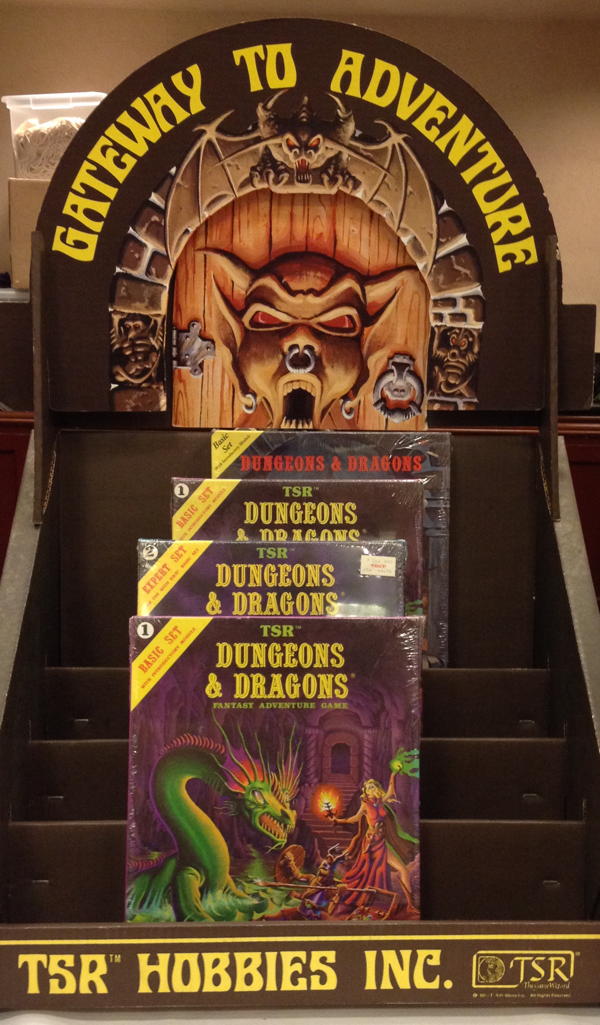
This display brought back memories. I don’t think I ever saw the product display, but the “Gateway to Adventure” image was on the TSR catalog that came with my Basic and Expert boxed sets, and it was filled with strange things I didn’t think I’d ever see.
Last June, I attended the North Texas RPG Con. This was my first gaming convention since Forge Midwest a couple of years ago. Like Forge Midwest, this is a gaming convention where all you do is game—and, of course, chat with people about gaming in between gaming.
I signed up ahead of time for five games, although I ended up having to cancel the first one due to my mis-entering the dates in my calendar. I ended up playing Villains and Vigilantes, D&D, Empire of the Petal Throne, and BX.
The Villains and Vigilantes game was under the new, third-edition rules, run by Jeff Dee. The rules seemed very similar to the old rules, except that the attack vs. defense table has been removed and replaced with a simpler d20 roll against a standard target number. And, while it didn’t affect us at the table, there is some sort of a point-based character-creation system.
The pre-gens were pure seventies superhero team, a bunch of mostly-unrelated heroes banding together to have a grand time. Running away with the MVP award, if we’d had one, would be The Schnozz, a Jimmy Durante type with a floppy hat and a big nose with precognitive smell.
“The future,” he said, “smells strange.”
-
 Vincent Price in House on Haunted Hill—Saturday, August 27th, 2016
Vincent Price in House on Haunted Hill—Saturday, August 27th, 2016
-
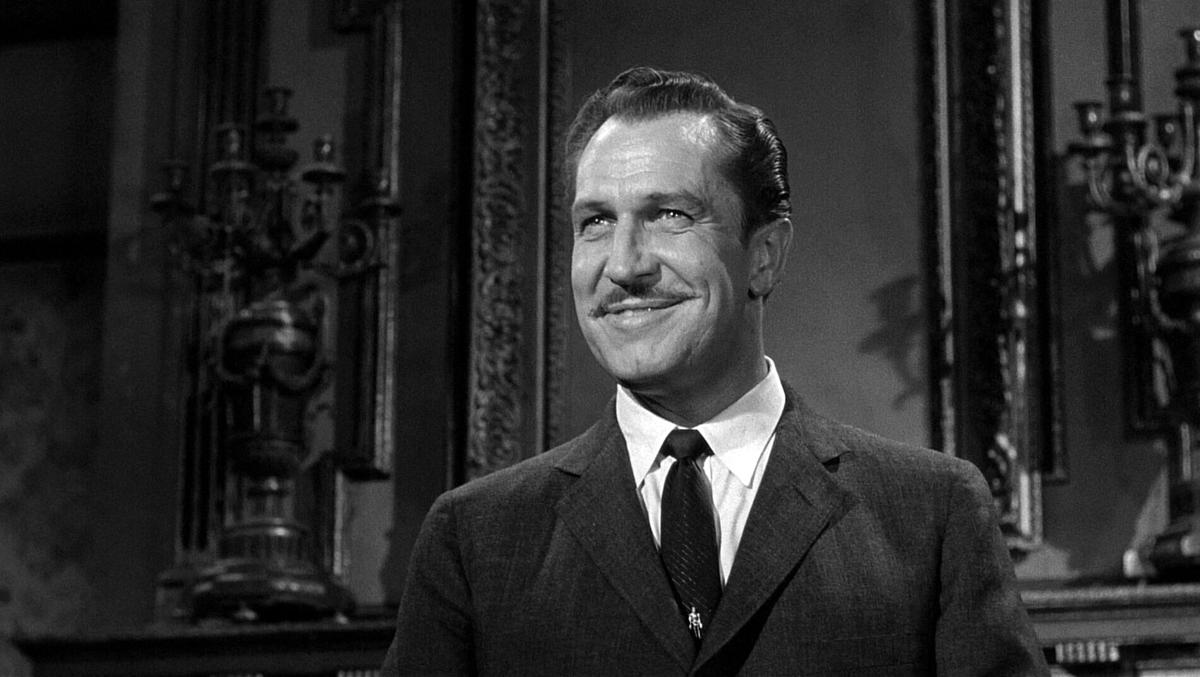
Oh, yes, we’re going to have fun tonight!
House on Haunted Hill•, with Vincent Price, certainly looks like it was inspired by The Haunting of Hill House•. No psychologists, but still, a group of talented and varied people invited to an old house along with the current owner who thinks it is a bad idea. The characters are accompanied by the owner, but, as in Hill House, are invited by a third party who is paying them to be there. In this case by Vincent Price’s millionaire, who promises them $10,000 each if they stay the night. As in Hill House, the doors are locked when the servants leave. And there’s the impressionable young woman lost in the maze of a house that seems to want to swallow her up. There are more similarities, but there are also important differences which would be spoilers.
And of course the title consists of the same three basic words.
Yet they appear to be completely unrelated. Shirley Jackson’s• The Haunting of Hill House• novel was published in 1959. The House on Haunted Hill movie was released on February 17, 1959. William Castle is known for the speed of his productions, but it seems very likely that the movie was written first. Unfortunately, I don’t know how to find full release dates, other than year, for novels, but to write the entire novel and have it go through the full publication process and still come out in 1959 makes it unlikely that Jackson was influenced by William Castle and Robb White’s script. The script does not appear to have been based on any previous work that Jackson could have been inspired by.
It still, however, seems extremely unlikely to me that these stories are not related in some way. The stories and title have too many similarities. While they are in no way copies of each other, if one was not inspired by the other, there must have been some other inspiration to both of them.
-
 The hauntings continue—Saturday, August 13th, 2016
The hauntings continue—Saturday, August 13th, 2016
-
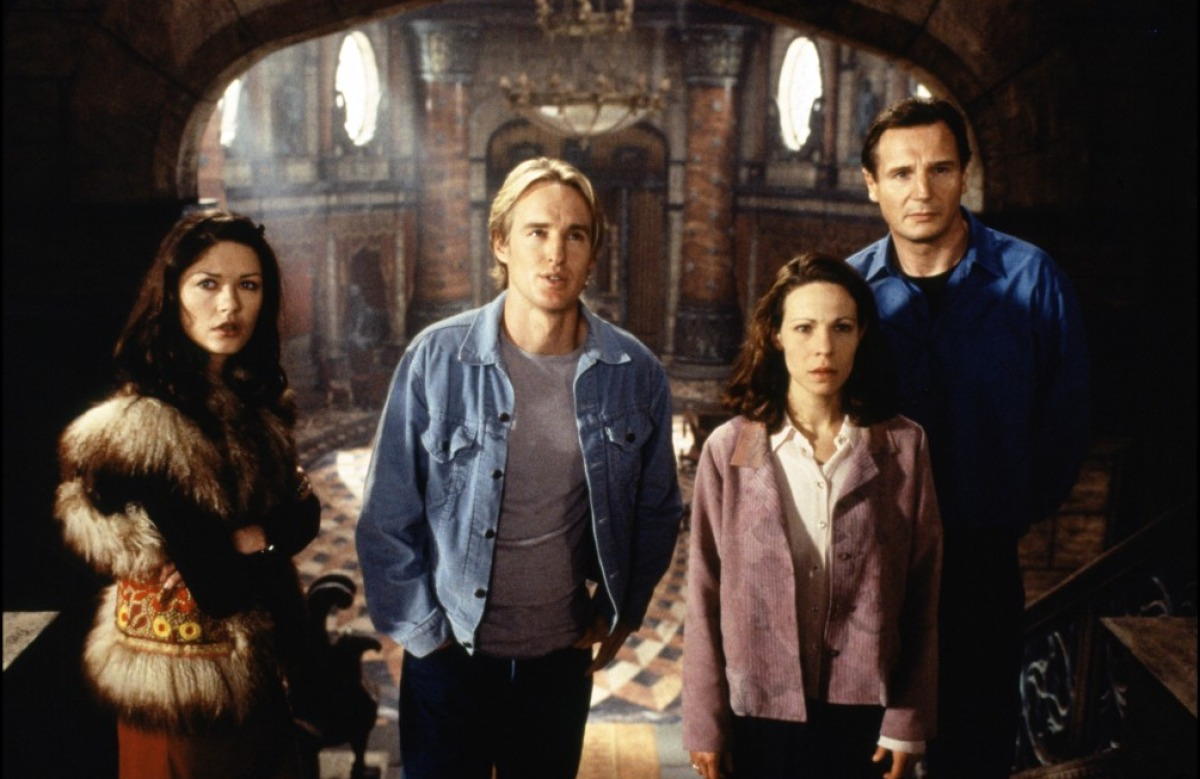
When there’s something bad… in your neighborhood… you probably don’t want to call this crew.
The Haunting•, with Liam Neeson, Catherine Zeta-Jones, Owen Wilson, and Lili Taylor, is a pretty good retelling of The Haunting of Hill House•, with permission. It’s a decent, though heavily flawed, psychological thriller until the over-the-top CGI at the end.
The high point of the film is the decent—and I mean that sincerely—acting by all involved. The film’s greatest lack is that Liam Neeson is woefully underused. His character, despite being the lynchpin of the plot, doesn’t actually do much. It looks as though there was supposed to be tension about whether he was causing all or some of the haunting•s but if so it was negated by perspectiveless scenes in which we see that the haunting is real. This also removes the other tension, which was the possibility that Eleanor is going crazy and hallucinating everything. If it’s happening when she isn’t present, then she’s not.
A lot of the tension was squandered by keeping things from the viewer that the characters knew (or thought they knew). We have no idea, for example, that Liam Neeson’s character might have invited Eleanor specifically until we find out that he didn’t.
We are never told why he has chosen the house or how he gained access to it. In the book, one of the heirs to the house accompanies them; his character is dropped from this version, but there’s a sort of completely wasted twist that plays on it.
For the new movie, they exchanged the old paranormal research subplot for fear research, but that makes these people nothing special. In the book, the psychic potential of the subjects awakens the house; in this version the house, presumably, is always awake. Except that it isn’t: as in any good horror movie, the house wakes up slowly, perhaps fed by blood. Or perhaps not, because by the end of the movie it seems that the house has been awake all along, and able to affect happenings far, far away.
-
 Vampires of York—Saturday, July 30th, 2016
Vampires of York—Saturday, July 30th, 2016
-
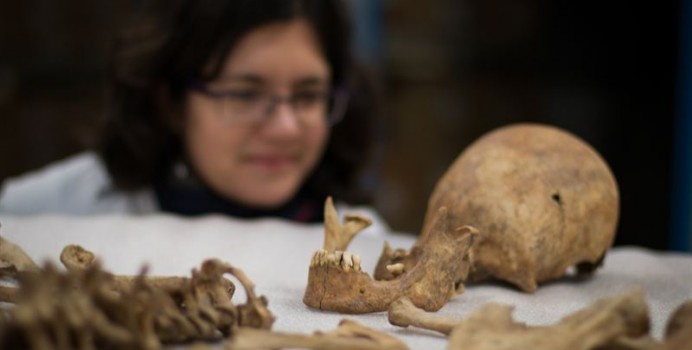
Scientist welcomes our old immortal overlords back to life… or unlife. (York Archaeological Trust)
Forget the werewolves of London. According to the July/August 2016 Archaeology a graveyard in Driffield Terrace in York contains Roman Empire-era men with their heads chopped off, the skulls buried “nearby”.
Some archaeologists are calling them gladiators, but according to University of St. Andrews archaeologist Jon Coulson,
…the idea that they had been gladiators [is] “wishful thinking.” Beheading wasn’t common for gladiators—or criminals, for that matter. Coulson says, “I see no connection between decapitation and gladiatorial displays.”
Archaeologists may be confused, but we know what decapitation means: some form of undead that can only be killed by removal of the head and separation of body parts.
I found a lot of other articles about the site, most of which posit either gladiatorial or military explanations for the skeletons. All of them mention the decapitation angle and then completely ignore it. Almost as if they know the truth but are conspiring not to panic the public… only the Guardian offers support for the gladiatorial theory, but that support is frightening:
Other theories about the grave have included a pagan rite involving decapitation, or a pogrom against a minority group such as Christians, but evidence for either is lacking. Gladiators were brought into the debate in earnest three years ago, when the discovery of burials of arena combatants at Ephesus in Turkey revealed a similar combination of hammer blows to the skull and decapitation as at York.
Ephesus is old Anatolia. That’s where young Vlad Dracul gained his power. Let’s hope the archaeologists aren’t storing the heads and the bodies in the same location…
-
 The Dungeon Master’s Adventure Log—Saturday, July 2nd, 2016
The Dungeon Master’s Adventure Log—Saturday, July 2nd, 2016
-
I had a fairly spotty source for gaming materials back in 1980–1981. My aunt and uncle in another town over had a variety store, and my cousins stocked one corner with TSR products. I’m not sure how much money they made on it, because they were probably their primary customers, and I and my brother got the family discount. That’s where I first picked up AD&D material, the Players Handbook, which added a third ruleset to our hybrid game, adding to the Holmes Blue Book that our DM had and the Moldvay/Cook Basic/Expert boxes that I got for Christmas.
I don’t recall ever seeing the Dungeon Masters Adventure Log• back in the day. I must have heard about it, as I attempted to recreate the basic idea for some of the games we played—mainly Men & Supermen. The Adventure Log is very much focused on dungeon adventures, with its emphasis on light sources and marching order in corridors. Each set of facing pages has space for listing characters on the left, and monsters/adventure information on the right. Pre-computer, this sort of thing would be very useful for recording what has happened to the characters in the past, as well as providing a summary of the last adventure for the DM to plan the next adventure.
Some of the other useful features are illustrations of common armor types as well as some of the less common weapons, that is, the weapons that players might not be able to easily envision. This means lots of pole arms for the most part. Back in the day, I used to wonder at TSR’s obsession with pole arms—so many illustrations were these weapons we never used. But in retrospect, everyone knew what a sword looked like, and few of us knew what a glaive-guisarme looked like. It made sense to overload the illustrations with more obscure weapons.
Another useful feature for those of us starting games from scratch would have been the example of use. It contained what looked like—and probably were—real characters from real games.


Role-playing reviews
Reviews related to role-playing games, with a focus on Gods & Monsters, and a bit of superhero gaming.

